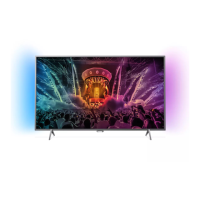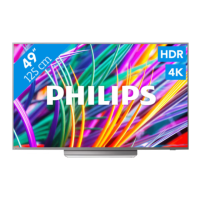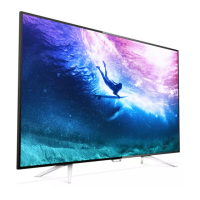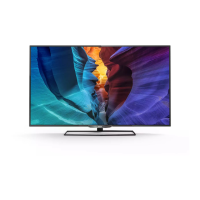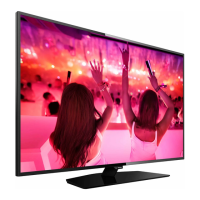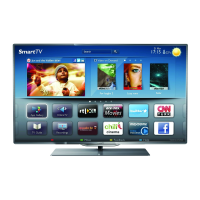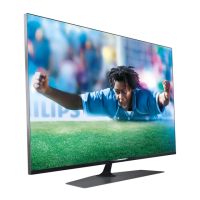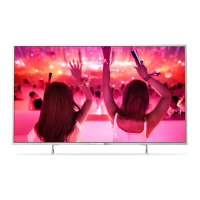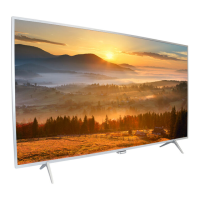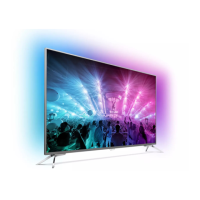
Do you have a question about the Philips 49PUS7101 and is the answer not in the manual?
| Screen shape | Flat |
|---|---|
| Response time | - ms |
| Display diagonal | 49 \ |
| Display brightness | 400 cd/m² |
| Display technology | LED |
| Native aspect ratio | 16:9 |
| Display diagonal (metric) | 123 cm |
| Screen format adjustments | Zoom |
| Supported graphics resolutions | 3840 x 2160 |
| Motion interpolation technology | - |
| 3D | No |
| User memory | 16 GB |
| Battery type | AA |
| Interactive TV | Yes |
| Refurbished grade | Grade A |
| Ambient lighting type | 3-sided |
| Annual energy consumption | 130 kWh |
| Number of batteries supported | 2 |
| RF connector type | F, IEC |
| HDMI ports quantity | 4 |
| DVI-D ports quantity | 0 |
| USB 2.0 ports quantity | 3 |
| Ethernet LAN (RJ-45) ports | 1 |
| Consumer Electronics Control (CEC) | EasyLink |
| Tuner type | Analog & digital |
| Analog signal format system | NTSC, PAL, SECAM |
| Digital signal format system | DVB-C, DVB-S, DVB-S2, DVB-T, DVB-T2, DVB-T2 HD |
| Video apps | YouTube |
| Lifestyle apps | Google Apps |
| Operating system installed | Android |
| Programming period | 8 day(s) |
| Firmware upgradeable via | Auto upgrade wizard, Network, USB |
| Audio decoders | DTS, DTS Premium Sound |
| RMS rated power | 30 W |
| AC input voltage | 220 - 240 V |
| AC input frequency | 50 - 60 Hz |
| Power consumption (standby) | 0.3 W |
| Power consumption (typical) | 89 W |
| Operating temperature (T-T) | 5 - 35 °C |
| Wi-Fi standards | 802.11a, Wi-Fi 5 (802.11ac), 802.11b, 802.11g, Wi-Fi 4 (802.11n) |
| Product color | Silver |
| Heavy metals free | Hg (mercury) |
| Panel mounting interface | 200 x 200 mm |
| Teletext standards | Hyper-text |
| Audio formats supported | AAC, MP3, WAV, WMA |
| Image formats supported | JPG |
| Video formats supported | AVC, AVI, H.264, H.265, MKV, MPEG1, MPEG2, MPEG4, VC-1, WMV9 |
| Subtitle formats supported | SMI, SRT, SUB, TXT |
| High Dynamic Range (HDR) technology | High Dynamic Range (HDR) 1500, High Dynamic Range 10+ (HDR10 Plus) |
| Package type | Box |
| Package depth | 160 mm |
| Package width | 1185 mm |
| Package height | 751 mm |
| Package weight | 18500 g |
| Cables included | AC |
| Depth (with stand) | 203 mm |
|---|---|
| Height (with stand) | 709 mm |
| Weight (with stand) | 14900 g |
| Depth (without stand) | 61 mm |
| Width (without stand) | 1093 mm |
| Height (without stand) | 644 mm |
| Weight (without stand) | 14500 g |
Describes the TV's Ultra HD display and resolution capabilities.
Explains the TV's Android OS, app access, and remote app integration.
Explains the Ambilight feature for enhanced visual experience with ambient lighting.
Emphasizes reading all safety instructions before using the TV to prevent hazards.
Provides guidance on installing the TV stand or mounting it on a wall securely.
How to connect the TV to a home network via wired or wireless connections.
Details network settings like Wi-Fi, Static IP, and file sharing capabilities.
Covers Android settings, app management, and Google Account sign-in procedures.
Guides on signing in with a Google Account to access TV features and apps.
Explains connecting devices, detailing HDMI, antenna, and quality considerations.
Covers HDMI ARC, MHL, and HDMI CEC for audio and device control.
Explains the requirements for connecting and using a USB Hard Drive for pause/record.
Connect wireless Bluetooth speakers, headphones, or gamepads for audio and gaming.
Steps for connecting a computer to use the TV as a PC monitor.
Explains how to switch the TV on, put it into standby, and disconnect power.
Provides a detailed overview of all the keys and their functions on the remote control.
Continues detailing remote control keys, including playback and channel navigation.
Explains how to use the remote's built-in keyboard for text input and navigation.
Guides on installing TV channels via antenna, cable, or satellite.
Explains subtitle and audio language settings for programmes.
Explains how channel lists work, filtering, and opening/selecting them.
Covers tuning to channels, switching, and using parental controls like channel locking.
How to open, navigate, and tune to programmes using the TV Guide.
Details requirements and steps for recording TV programs, including scheduling.
Covers managing recordings, auto end margin, and manual recording setup.
Explains how to pause and resume live TV broadcasts using a USB drive.
Overview of the Home menu as the central hub for apps, channels, and settings.
How to switch between different connected devices and inputs.
Overview of apps available on the TV, from Philips App Gallery and Google Play.
Guides on using Google Play Movies & TV for renting or buying content.
Requirements for playing games, including internet connection and app installation.
How to start and play games from the Home menu or a connected game console.
Steps to launch the TV's internet browser and navigate websites.
How to view photos, play music, and videos from a connected USB storage device.
Instructions for playing video files, including playback controls and options.
How to use the Philips TV Remote App for controlling the TV and accessing features.
Guides on casting apps and content from mobile devices to the TV screen.
How to set Ambilight to follow video or audio dynamics, or choose preset styles.
Details available Follow Video and Follow Audio styles for dynamic lighting effects.
Explains sound styles like Personal, Movie, Music, and Game for audio tuning.
Instructions for automatic and manual channel updates for antenna/cable reception.
Guides on installing satellites, including Unicable systems and MDU support.
Troubleshooting guides for Wi-Fi, internet, Bluetooth connectivity, and menu language issues.
Initial troubleshooting steps for common issues like power and remote control problems.
Crucial safety instructions to read before use, covering electrical safety and secure mounting.
